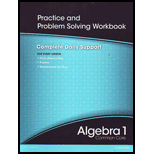
Concept explainers
Your dad can clean the house in 2 hours and 10 minutes. Your mom can clean it in an hour and 45 minutes. How many hours does it take them to clean the house if they work together?
To calculate the time taken to clean the house together.
Answer to Problem 14P
The time taken for cleaning the house together is
Explanation of Solution
Given information:
The given statement is:
“Your dad can clean the house in
Calculation:
Time taken by dad to clean the house is
Work done by dad is
Time taken by mom to clean the house is an hour and
Work done by mom is
The work done together can be calculated by:
The time taken for cleaning the house together is:
Hence, the time taken for cleaning the house together is
Chapter 11 Solutions
High School Math 2012 Common-core Algebra 1 Practice And Problem Solvingworkbook Grade 8/9
Additional Math Textbook Solutions
College Algebra (7th Edition)
Algebra and Trigonometry (6th Edition)
Elementary Statistics: Picturing the World (7th Edition)
Intro Stats, Books a la Carte Edition (5th Edition)
Pre-Algebra Student Edition
- Let 2 A = 4 3 -4 0 1 (a) Show that v = eigenvalue. () is an eigenvector of A and find the corresponding (b) Find the characteristic polynomial of A and factorise it. Hint: the answer to (a) may be useful. (c) Determine all eigenvalues of A and find bases for the corresponding eigenspaces. (d) Find an invertible matrix P and a diagonal matrix D such that P-¹AP = D.arrow_forward(c) Let 6 0 0 A = -10 4 8 5 1 2 (i) Find the characteristic polynomial of A and factorise it. (ii) Determine all eigenvalues of A and find bases for the corresponding eigenspaces. (iii) Is A diagonalisable? Give reasons for your answer.arrow_forwardmost 2, and let Let P2 denote the vector space of polynomials of degree at D: P2➡ P2 be the transformation that sends a polynomial p(t) = at² + bt+c in P2 to its derivative p'(t) 2at+b, that is, D(p) = p'. (a) Prove that D is a linear transformation. (b) Find a basis for the kernel ker(D) of the linear transformation D and compute its nullity. (c) Find a basis for the image im(D) of the linear transformation D and compute its rank. (d) Verify that the Rank-Nullity Theorem holds for the linear transformation D. (e) Find the matrix representation of D in the standard basis (1,t, t2) of P2.arrow_forward
- (c) Let A = -1 3 -4 12 3 3 -9 (i) Find bases for row(A), col(A) and N(A). (ii) Determine the rank and nullity of A, and verify that the Rank-Nullity Theorem holds for the above matrix A.arrow_forward-(0)-(0)-(0) X1 = x2 = x3 = 1 (a) Show that the vectors X1, X2, X3 form a basis for R³. y= (b) Find the coordinate vector [y] B of y in the basis B = (x1, x2, x3).arrow_forwardLet A 1 - 13 (1³ ³) 3). (i) Compute A2, A3, A4. (ii) Show that A is invertible and find A-¹.arrow_forward
- Let H = {(a a12 a21 a22, | a1 + a2 = 0} . € R²x²: a11 + a22 (i) Show that H is a subspace of R2×2 (ii) Find a basis of H and determine dim H.arrow_forward2 5 A=1 2 -2 b=2 3 1 -1 3 (a) Calculate det(A). (b) Using (a), deduce that the system Ax = b where x = (x1, x2, x3) is consistent and determine x2 using Cramer's rule.arrow_forwardConsider the least squares problem Ax = b, where 12 -09-0 A 1 3 1 4 and b = (a) Write down the corresponding normal equations. (b) Determine the set of least squares solutions to the problem.arrow_forward
- The function f(x) is represented by the equation, f(x) = x³ + 8x² + x − 42. Part A: Does f(x) have zeros located at -7, 2, -3? Explain without using technology and show all work. Part B: Describe the end behavior of f(x) without using technology.arrow_forwardHow does the graph of f(x) = (x − 9)4 – 3 compare to the parent function g(x) = x²?arrow_forwardFind the x-intercepts and the y-intercept of the graph of f(x) = (x − 5)(x − 2)(x − 1) without using technology. Show all work.arrow_forward
 Algebra and Trigonometry (6th Edition)AlgebraISBN:9780134463216Author:Robert F. BlitzerPublisher:PEARSON
Algebra and Trigonometry (6th Edition)AlgebraISBN:9780134463216Author:Robert F. BlitzerPublisher:PEARSON Contemporary Abstract AlgebraAlgebraISBN:9781305657960Author:Joseph GallianPublisher:Cengage Learning
Contemporary Abstract AlgebraAlgebraISBN:9781305657960Author:Joseph GallianPublisher:Cengage Learning Linear Algebra: A Modern IntroductionAlgebraISBN:9781285463247Author:David PoolePublisher:Cengage Learning
Linear Algebra: A Modern IntroductionAlgebraISBN:9781285463247Author:David PoolePublisher:Cengage Learning Algebra And Trigonometry (11th Edition)AlgebraISBN:9780135163078Author:Michael SullivanPublisher:PEARSON
Algebra And Trigonometry (11th Edition)AlgebraISBN:9780135163078Author:Michael SullivanPublisher:PEARSON Introduction to Linear Algebra, Fifth EditionAlgebraISBN:9780980232776Author:Gilbert StrangPublisher:Wellesley-Cambridge Press
Introduction to Linear Algebra, Fifth EditionAlgebraISBN:9780980232776Author:Gilbert StrangPublisher:Wellesley-Cambridge Press College Algebra (Collegiate Math)AlgebraISBN:9780077836344Author:Julie Miller, Donna GerkenPublisher:McGraw-Hill Education
College Algebra (Collegiate Math)AlgebraISBN:9780077836344Author:Julie Miller, Donna GerkenPublisher:McGraw-Hill Education





